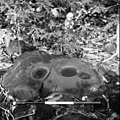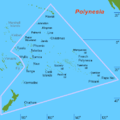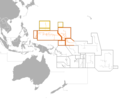An orthographic projection of Oceania
Oceania OH -s(h)ee-AH -nee-ə, -AY -OH -shee-A(H)N -ee-əgeographical region including Australasia , Melanesia , Micronesia , and Polynesia . Outside of the English-speaking world, Oceania is generally considered a continent, while Australia is regarded as an island or a continental landmass contained inside of the larger continent of Oceania. Spanning the Eastern and Western Hemispheres , at the centre of the water hemisphere , Oceania is estimated to have a land area of about 9,000,000 square kilometres (3,500,000 sq mi) and a population of around 44.4 million as of 2022. When compared to the continents (which it is often compared to, not including Australia), Oceania is the smallest in land area and the second-least populated after Antarctica .
Oceania has a diverse mix of economies from the highly developed and globally competitive financial markets of Australia , French Polynesia , Hawaii , New Caledonia , and New Zealand , which rank high in quality of life and Human Development Index , to the much less developed economies of Kiribati , Papua New Guinea , Tuvalu , Vanuatu , and Western New Guinea , while also including medium-sized economies of Pacific islands such as Fiji , Palau , and Tonga . The largest and most populous country in Oceania is Australia, and the largest city is Sydney . Puncak Jaya in Highland Papua , Indonesia , is the highest peak in Oceania at 4,884 m (16,024 ft).
The arrival of European settlers in subsequent centuries resulted in a significant alteration in the social and political landscape of Oceania. The Pacific theatre saw major action during the First World War with the Japanese occupying many German territories. During the Second World War , Allied powers the United States , Philippines (a U.S. Commonwealth at the time) and Australia fought against Axis power Japan across various locations in Oceania. (Full article...
Tuvalu too-VAH -loo Ellice Islands , is an island country in the Polynesian subregion of Oceania in the Pacific Ocean , about midway between Hawaii and Australia . It lies east-northeast of the Santa Cruz Islands (which belong to the Solomon Islands ), northeast of Vanuatu , southeast of Nauru , south of Kiribati , west of Tokelau , northwest of Samoa and Wallis and Futuna , and north of Fiji .
Tuvalu is composed of three
reef islands and six
atolls spread out between the
latitude of
5° and
10° south and between the
longitude of
176° and
180° . They lie west of the
International Date Line . The 2017 census determined that Tuvalu had a population of 10,645, making it
the second-least populous country in the world , behind
Vatican City . Its total land area is 26 square kilometres (10 sq mi). (
Full article... )
List of geographic articles
The following are images from various Oceania-related articles on Wikipedia.
Image 3 Languages of Micronesia. (from
Micronesia )
Image 4 Polynesian (Hawaiian) navigators sailing multi-hulled
canoe , c. 1781 (from
Polynesia )
Image 6 Mokoliʻi Isle near
Oahu ,
Hawaii (from
Polynesia )
Image 7 Carving from the ridgepole of a
Māori house, ca 1840 (from
Polynesia )
Image 8 Cinder plain of
Mount Yasur in
Vanuatu (from
Melanesia )
Image 9 Kili Island is one of the smallest islands in the
Marshall Islands . (from
Micronesia )
Image 10 A pan flute from
Solomon Islands , 19th century (from
Melanesia )
Image 11 Grinding stones discovered from
archaeology in Samoa (from
Polynesia )
Image 12 Micronesia is one of three major cultural areas of the
Pacific Ocean islands , along with
Melanesia and
Polynesia . (from
Micronesia )
Image 13 Outline of sovereign (dark orange) and dependent islands (bright orange) (from
Melanesia )
Image 14 A
Melanesian child from
Vanuatu (from
Melanesia )
Image 15 Map of Melanesia, showing its location within Oceania (from
Melanesia )
Image 16 An illustration of the Cross Spikes Club of the US Navy on
Bikini Atoll , one of several Marshall Islands used for
atomic bomb tests . (from
Micronesia )
Image 17 Subregions (
Melanesia ,
Micronesia ,
Polynesia and
Australasia ), as well as sovereign and dependent islands of
Oceania (from
Micronesia )
Image 20 King
Kamehameha I receiving the Russian naval expedition of
Otto von Kotzebue . Drawing by
Louis Choris in 1816. (from
Polynesia )
Image 21 Mount Marpi in
Saipan . (from
Micronesia )
Image 22 Painting of
Tahitian Women on the Beach by
Paul Gauguin —
Musée d'Orsay (from
Polynesia )
Image 23 Polynesia is generally defined as the islands within the
Polynesian Triangle . (from
Polynesia )
Image 24 Outline of sovereign (dark orange) and dependent islands (bright orange) (from
Micronesia )
Image 25 A depiction of a royal
heiau (Hawaiian temple) at
Kealakekua Bay , c. 1816 (from
Polynesia )
Image 26 Chamorro people in 1915 (from
Micronesia )
Image 27 Aerial view of
Solomon Islands (from
Melanesia )
Image 29 Moai at Ahu Tongariki on
Rapa Nui (from
Polynesia )
Image 30 Sailors of Melanesia in the
Pacific Ocean , 1846 (from
Melanesia )
Image 31 Image of the
Castle Bravo nuclear test, detonated on 1 March 1954, at
Bikini Atoll (from
Micronesia )
Image 32 German New Guinea before and after the German-Spanish treaty of 1899 (from
Micronesia )
Image 33 Chronological dispersal of
Austronesian peoples across the
Indo-Pacific (from
Melanesia )
Image 34 Polynesians with
outrigger canoes at
Waikiki Beach ,
Oahu Island , early 20th century (from
Polynesia )
Image 35 The arrival of
Abel Tasman in
Tongatapu , 1643; drawing by
Isaack Gilsemans (from
Polynesia )
Image 36 Polynesia is one of three major cultural areas of the
Pacific Ocean islands , along with
Melanesia and
Micronesia . (from
Polynesia )
Image 37 A common fishing canoe
va'a with outrigger in
Savaiʻi island,
Samoa , 2009 (from
Polynesia )
Image 38 Canoe carving on
Nanumea atoll, Tuvalu (from
Polynesia )
Image 39 German trading station at
Jaluit Atoll with a Marshallese
korkor outrigger canoe in the foreground (from
Micronesia )
Image 40 Subregions (
Melanesia ,
Micronesia , Polynesia, and
Australasia ), as well as sovereign and dependent islands of
Oceania (from
Polynesia )
Image 43 The Polynesian spread of colonization in the Pacific (from
Polynesia )
Image 44 Australia's concept of Australasia, which includes Australia, New Zealand and, in this case,
Melanesia (from
Australasia )
Image 45 Outline of sovereign (dark orange) and dependent islands (bright orange) (from
Polynesia )
Image 46 Beach scenery at
Laura ,
Majuro , Marshall Islands (from
Micronesia )
Image 47 Māori
war canoe drawn after
James Cook 's voyage to New Zealand. (from
Polynesia )
Image 48 Cook's Bay on
Moorea ,
French Polynesia (from
Polynesia )
Image 49 Map showing the migration and expansion of the
Austronesians which began at about 3000 BC from
Taiwan . The Polynesian branch is shown in green. (from
Polynesia )
Image 50 Melanesia is one of three major cultural areas of the
Pacific Ocean islands , along with
Micronesia and
Polynesia . (from
Melanesia )
Image 51 Chronological dispersal of
Austronesian peoples across the
Indo-Pacific (from
Micronesia )
Image 52 On February 14, 1779, Capt.
James Cook was killed on the island of Hawaii (from
Polynesia )
Australasia Melanesia Micronesia Polynesia
Adamstown Pitcairn Islands 6 Alofi Niue 7 Apia Samoa Avarua Cook Islands 7 Fakaofo Tokelau 8 Funafuti Tuvalu Mata Utu Wallis and Futuna 2 Nukuʻalofa Tonga Pago Pago American Samoa 4 Papeete French Polynesia 2
Category puzzle Select [►] to view subcategories
Here are some tasks awaiting attention:
Wikipedia in other languages used in Oceania:
Purge server cache







































































